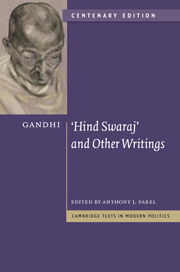Book contents
- Frontmatter
- Contents
- Preface to the centenary edition
- Acknowledgements
- Editor's introduction to the centenary edition
- Editor's introduction to the 1997 edition
- A note on the history of the text
- Principal events in Gandhi's life
- Biographical synopses
- Guide to further reading
- Glossary and abbreviations
- HIND SWARAJ
- Contents
- Preface to the English translation
- Foreword
- I The Congress and its officials
- II The Partition of Bengal
- III Discontent and unrest
- IV What is Swaraj?
- V The condition of England
- VI Civilisation
- VII Why was India lost?
- VIII The condition of India
- IX The condition of India (cont.): railways
- X The condition of India (cont.): the Hindus and the Mahomedans
- XI The condition of India (cont.): lawyers
- XII The condition of India (cont.): doctors
- XIII What is true civilisation?
- XIV How can India become free?
- XV Italy and India
- XVI Brute force
- XVII Passive resistance
- XVIII Education
- XIX Machinery
- XX Conclusion
- I APPENDICES
- SUPPLEMENTARY WRITINGS
- Bibliography
- Index
II - The Partition of Bengal
Published online by Cambridge University Press: 05 October 2014
- Frontmatter
- Contents
- Preface to the centenary edition
- Acknowledgements
- Editor's introduction to the centenary edition
- Editor's introduction to the 1997 edition
- A note on the history of the text
- Principal events in Gandhi's life
- Biographical synopses
- Guide to further reading
- Glossary and abbreviations
- HIND SWARAJ
- Contents
- Preface to the English translation
- Foreword
- I The Congress and its officials
- II The Partition of Bengal
- III Discontent and unrest
- IV What is Swaraj?
- V The condition of England
- VI Civilisation
- VII Why was India lost?
- VIII The condition of India
- IX The condition of India (cont.): railways
- X The condition of India (cont.): the Hindus and the Mahomedans
- XI The condition of India (cont.): lawyers
- XII The condition of India (cont.): doctors
- XIII What is true civilisation?
- XIV How can India become free?
- XV Italy and India
- XVI Brute force
- XVII Passive resistance
- XVIII Education
- XIX Machinery
- XX Conclusion
- I APPENDICES
- SUPPLEMENTARY WRITINGS
- Bibliography
- Index
Summary
reader: Considering the matter as you put it, it seems proper to say that the foundation of Home Rule was laid by the Congress. But you will admit that it cannot be considered a real awakening. When and how did the real awakening take place?
editor: The seed is never seen. It works underneath the ground, is itself destroyed, and the tree which rises above the ground is alone seen. Such is the case with the Congress. Yet, what you call the real awakening took place after the Partition of Bengal. For this we have to be thankful to Lord Curzon. At the time of the Partition, the people of Bengal reasoned with Lord Curzon, but, in the pride of power, he disregarded all their prayers – he took it for granted that Indians could only prattle, that they could never take any effective steps. He used insulting language, and, in the teeth of all opposition, partitioned Bengal. That day may be considered to be the day of the partition of the British Empire. The shock that the British power received through the Partition has never been equalled by any other act. This does not mean that the other injustices done to India are less glaring than that done by the Partition. The salt-tax is not a small injustice. We shall see many such things later on. But the people were ready to resist the Partition. At that time, the feeling ran high. Many leading Bengalis were ready to lose their all.
- Type
- Chapter
- Information
- Gandhi: 'Hind Swaraj' and Other Writings , pp. 19 - 22Publisher: Cambridge University PressPrint publication year: 2009

